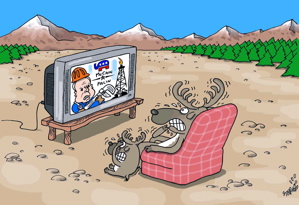US presidential race: Is there a green candidate?
 With the economic crisis now setting the US political agenda, don’t expect either McCain or Obama to take the lead on climate change – look to Congress instead.
With the economic crisis now setting the US political agenda, don’t expect either McCain or Obama to take the lead on climate change – look to Congress instead.With the US financial system on the brink of collapse, the economy will undoubtedly take centre stage as the presidential campaign enters its final month. Where does that leave climate change?
It’s easy to assume that whoever ends up in the White House will act on global warming – but given the huge spin generated by presidential campaigns, it is important to understand the realities that lie beneath what seem like pretty impressive commitments.
In his relatively short time as a senator, Obama supported cap-and-trade legislation, though he was never an outspoken advocate and maintained strong ties to the coal and corn industries. Candidate Obama, however, strongly supports action on climate change in general and a US cap-and-trade programme in particular.
As a senator, McCain was an vocal advocate of cap and trade, sponsoring multiple proposals in the Senate. But candidate McCain has dropped climate policy from the majority of his speeches, and his selection of Sarah Palin as his running mate raises questions about his commitment to mandatory action.
The reality is that the winning candidate will be faced with three options to address climate change, with one of these options more likely to be adopted that the rest.
First, the president could use the US Environmental Protection Agency to put a cap on greenhouse gas emissions using the Clean Air Act as justification. However, this would mean spending a significant amount of political capital, which presidents usually save for their highest priorities. With a poor economy and high energy prices, neither candidate is likely to invest too much in a policy that still does not have overwhelming public support.
Second, the president could use the “bully pulpit” to encourage Congress to address the issue. Again, this would require precious political capital that neither man will want to cash in on climate policy, especially McCain, whose base supporters are calling for increased domestic drilling for fossil fuels.
Power lies with Congress
Third – and far more likely – is that the next president will simply say that this is an issue for Congress. He can thereby maintain his campaign position to address the issue by saying that if Congress passes legislation, he will sign it.
How long it will take Congress to do that is a separate issue, and one that will have consequences domestically and internationally. Although there is still hope the US will sign up to a post-Kyoto deal, the new president will only have around 10 months to get ready for Copenhagen. US legislation would ideally need to be in place before that, so hopefully Congress will acting aggressively.
In light of the above, it is easy to be frustrated about how little political attention climate change is receiving once you scratch beneath the surface. However, there are two basic levers that could still result in a meaningful reduction in US carbon emissions.
The energy argument
The high cost of energy in the US has been used to argue for more domestic drilling and the lifting of bans on offshore oil exploration, often couched in terms of easing dependence on imported oil for the benefit of national security.
Soaring energy costs, however, also provide an effective argument for pursuing alternative energy sources – but although there has been some progress, the case for renewables has not yet been supported by policy.
It is likely we will see increased efforts on energy efficiency and conservation. And while clear and consistent policy on climate change would be preferable to the vagaries of the market (automobile fuel efficiency also climbed quickly following the 1973 energy crisis, then did not move much for 30 years), cutting energy waste will benefit the planet as well making US companies more competitive.
States take the lead
In the meantime, there has been a growing policy response to climate change at a state and regional level, which could lay the groundwork for national action. US states are proving useful laboratories for low-carbon development.
The Regional Greenhouse Gas Initiative (RGGI) was launched on September 25 and is the first mandatory, market-based effort in the US to reduce emissions. Ten north-eastern and mid-Atlantic states will cap and then reduce CO2 emissions from the power sector by 10% before 2018.
States will sell emission allowances through auctions and invest proceeds in consumer benefits: efficiency, renewables and other clean-energy technologies. RGGI will spur innovation in the clean-energy economy and create green jobs in each state – a win-win situation.
California has recently released a second economic assessment plan for implementing AB 32 (California Global Warming Solutions Act of 2006). The new report contains more detail than its predecessor, but its conclusions were broadly similar: that moving forward with plans to cut GHGs will benefit the economy, provide jobs and new sources of economic activity.
The bottom line is that despite the pronouncements of the candidates on climate change, they will not be able to move forward without the support of Congress, and this will require dramatic shifts by representatives from the Midwest and Southern states.
While America may lose a few pounds of carbon simply through cost-cutting by companies and consumers, the world will not be able to look forward to meaningful action from the US until Congress adopts a more proactive and consistent approach. However, at least the world will not be faced with a president who actively blocks progress on climate change.
Emily Farnworth is director of corporate engagement at The Climate Group.
You can return to the main Market News page, or press the Back button on your browser.

